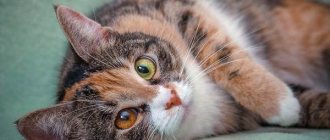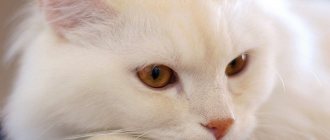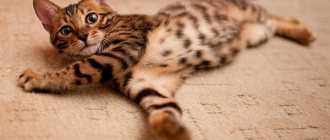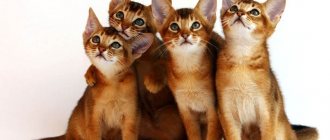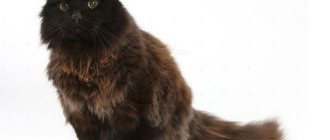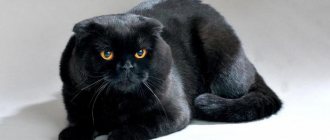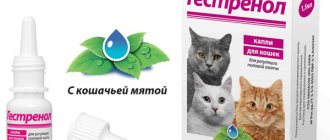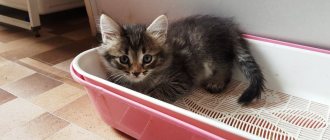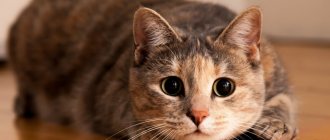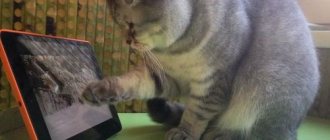“The simplicity of the genes of the white spot series, represented by a bi-allelic system of a single dominant gene S and a single recessive gene s, is very deceptive. Despite many unproven versions and assumptions, the problem of inheritance of white spotting still remains a mystery. The GCCF standards, very strict at the beginning and too streamlined and ill-conceived later, bring only chaos and confusion to the work of judges and breeders. However, experience has taught us two simple truths.
Firstly, the proportions of white and color in bicolors are acceptable within fairly generous limits. Those who demand a pedantic and clear division between colored and white are victims of voluntary delusion.
Secondly, when crossing bicolors, there is often a tendency to accumulate the proportion of white in color in subsequent generations. Therefore, bicolors with a small amount of white are simply necessary in a balanced nursery program.
Bicolors in which white occupies less than 50% of the total color area are quite likely to be heterozygous for the white spotting gene (Ss), which means: such animals can produce kittens without white in their offspring. Bicolors in which white occupies more than 50% of the total color area are virtually always homozygous for the white spotting gene (SS). In the case of a clear predominance of white in color, cats, just like white (W-), can have differently colored eyes.
No less mysterious and enigmatic is the genetic basis of the Burmese gloves. In fact, perfect white gloves, socks and spurs are a matter of chance and luck, so the breed type should exceed millimeter differences in the length of spurs or other inaccuracies in white markings, if they do not fall under the punitive functions of the Standard.
Black and white, double colors in cats
Cat colors have been very diverse since ancient times, since representatives of the cat family are ancient predators, camouflaging themselves in the environment for hunting. During the selection of domestic cats, colors have become even more multiple and varied, and in modern felinology the concept of color includes not only the color of the coat, but also the pattern on the cat’s coat and the degree of coloration, types of hair shades.
As we found out, cats have two-color (not only black and white, but snow-white + another color) color is called bicolor. Although animals of two colors have long existed in the wild (for example, pandas), bicolor for cats only became standard in 1969. At this time, several cats of this color were presented at the World Felinological Exhibition, and it became popular overnight. Bicolors, which were previously considered defective, began to be actively bred.
Black bicolor cat
How much does a kitten cost?
If you decide to choose a Siberian as a companion, you should decide in what capacity you want to see him.
A pet-class kitten is only suitable as a pet. The price for it in Russian nurseries is fifteen to twenty thousand rubles.
For breeding, you need to choose a pet with an excellent genetic makeup - you should familiarize yourself with the pedigrees, color and type of parents. Find out if your cat has any birth defects. Depending on the color, uniqueness of the kitten, the fame of the nursery and the titles of relatives, the cost of the baby can reach one hundred thousand rubles.
The price of a show-class cat is approximately in the same range. With this pet you need to earn championship titles.
Siberian animals have a big advantage over other breeds - they are less likely to cause allergies. This is due to the low content of protein in saliva - the main factor of pathology.
On Avito today you can find offers to buy a real Siberian cat for three thousand rubles. You should not support scammers and scammers. This is one of the few Russian breeds that you can be proud of and need to support.
The Siberian cat is a classic representative of domesticated cats, which does not have a very original appearance, but its popularity has not waned over the years. What is the history of the origin of the breed, what attracts these cats, and what should future owners know about this Siberian beauty?
Three types of black and white colors
Only at first glance does it seem that all black and white cats are the same. In fact, there are three variations of black and white cats, which are very easily identified visually.
Table 1. Black and white colors
| Color type | Peculiarities |
| "Van" | The main color of the cat's coat is white, with several small black spots on it. Usually one or two spots are located on the body, closer to the tail, and several more on the head and face of the animal. |
| "Harlequin" | Cats of the “harlequin” type also have a snow-white color, on which there are already larger and multiple black spots. Spots are a symbol, the black pattern can be anything, combining stripes, small patterns, spots and large areas of fur, charcoal in color. The main thing is that there is no white hair inside the black spot, regardless of its size and location on the cat’s body. |
| "Bicolor" | The main color is blue-black, with snow-white spots of different shapes and sizes located on it. The classic version of bicolor is white markings on the animal’s limbs, head, muzzle, sides, as well as a “tie” in the chest area. |
Variety of colors in kittens in one litter
Breeding bicolor kittens
Getting black and white kittens with the “right” color is not an easy job for a breeder. The fact is that the bicolor color requires that predominantly the upper part of the body (along the spine and below) be well colored, the spots do not mix with each other, do not merge and have a beautiful and clear border. In addition, black and white cats, whose spots are located symmetrically, are highly valued, but since it is impossible to predict this in advance, it is these animals that are extremely rare and have the highest value.
To get a bicolor black and white kitten, breeders breed either a bicolor parent pair or a bicolor cat of the desired color with a tortoiseshell cat. Depending on which combination of parental genes was used, kittens can be born with different shades of fur - up to twenty color and shade variations. Therefore, breeding bicolor kittens is not only very difficult, but also extremely interesting for breeders.
Breeders do not always produce kittens of the “intended” black and white color
Note that in black and white cats, interesting combinations are produced not only by the spots on the fur coat, but also by the pigmentation of the nose, lips and pads on the paws. Bicolor cats often have black markings of various shapes on the nose, and the pads can be black and pink - this is due to the color of the hairs on the fingers.
Eye shades in black and white cats also have different variations. Green eyes are more common, but there can also be honey, golden, orangish, and less often blue and other shades of blue. Bicolor cats may have heterochromia (different colored eyes). If white color predominates on one half of the muzzle, the eye will most likely be blue, but if the second part of the head is black, the eye will be green.
Odd-eyed black and white cat
On our portal you can get acquainted with the breeds in which you can find a black color with bright green eyes, as well as which breeds include white blue-eyed cats.
General characteristics, breed standard
All associations have a common characteristic of the Siberian beauty: a powerful, muscular animal of medium to large size, with a good-natured expression on the face, and semi-long hair. Animals of late development - the final formation of an individual is completed by the age of five.
Description of the external characteristics of the Siberian Cat breed according to the TICA felinological system:
- Head. Triangular with rounded transitions. The forehead is wide, the chin is narrow. The cheeks are large and rounded. The forehead is flat and goes smoothly to the nose.
- Ears. The middle ones, widely spaced, taper to a rounded tip. Slight lean forward. The inside is heavily pubescent, tassels at the ends are welcome.
- Nose. Medium length and width, the transition line from the forehead to the nose is smooth with a slight break. In line with the chin.
- Chin. Well developed, strong, round.
- Mustache. The pods are clearly defined and well developed.
- Eyes. Round shape, round is acceptable. Slightly narrowed towards the outer corner. Any color, regardless of coat color.
- Neck. Powerful, medium length. Visually it appears shorter due to the large fur collar.
- Body. The skeleton is medium, the muscles are well developed. The back is wider than the front. Gives the impression of power, heaviness and strength, especially in cats.
- Paws. The hind ones are longer than the front ones. Length - medium, wide and powerful, pads with edge between fingers, powerful.
- Tail. Shorter than the body length, wide, evenly pubescent, rounded tip.
- Wool. Consists of semi-long main hair - hard and shiny, with water-repellent properties. Double undercoat. Its density depends on the time of year. In warm weather - short, in winter and autumn - voluminous, long, very warm. Characterized by a lush “collar”, wide “pants” on the hind legs, and a plumed tail. Subject to seasonal molting.
- Colors. Numerous and varied - black, blue, red, tortoiseshell, tabby, others.
- Weight. They differ greatly by gender. In females up to six, in males - up to twelve kilograms.
- Crossbreeding is only allowed within the breed.
Disadvantages: poorly formed center hair or undercoat of insufficient length. Poorly developed cheeks, chin, body. Ears that are set too close together are too long and small and low. Short tail, small paws, graceful build, too long neck.
- excessively even profile or snub nose like the Persians;
- elongated narrow head, creating the impression of lightness;
- small, deep-set eyes;
- poor wool quality, poor health.
Black and white cat breeds
Bicolor colors are not uncommon both for outbred cats and for their relatives with a pedigree. There is a large layer of breeds in which black and white cats have been bred for years, achieving a certain pattern. So, in some breeds it is important that the white pattern on black fur be as symmetrical as possible, covering all four limbs, head, and body; in other cats this is not at all important.
Below we will get acquainted with cat breeds in which the appearance of a black and white kitten is considered the standard norm. Let us note right away that black bicolor is usually not considered valuable, so kittens of this color will cost the same as their littermates with fur of other shades.
Black and white kittens from the same litter
British cat
The classic color for British cats has long been considered blue or smoky, and many people wanted to buy just such a kitten. Over time, the breed became widespread, and breeders began to offer British cats of various colors, including bicolors.
Professional felinologists call the white spots of the British “piebold spotting”, and divide the colors of British cats as follows:
- “Van” is more than 90% white in color.
- “Harlequin” or “marquise” - white color occupies 5/6 of the total color.
- “Bicolor” - white takes up from half to a third of the total color.
In a special article we will tell you about the characteristics of British black cats, their history, character and care for them.
Another variation in the color of British cats is the mitted, which is not recognized by felinologists and is considered a disadvantage for a purebred pet. The coloration is characterized by a white stripe that runs from the chin to the chest, along the stomach, the inner surfaces of the paws and in the groin. Sometimes cats of the mitted color have white “socks” or “knee socks”.
The British are headstrong but friendly
British cats are very independent, proud and even narcissistic creatures, so all family members should respect their personal space and not unnecessarily torment the pet with attention. But if a Briton wants to show his feelings for family members, then he turns into the most affectionate and gentle animal in the world. This changeable temperament attracts many owners who consider their British cats to be real individuals. This is why black and white Britons are so popular - they not only have a strong character, but also a truly individual appearance!
British Harlequins
Video - British bicolor kittens
Oriental cat
The Oriental breed is perhaps the most variegated in the cat world, as there are over two hundred different color variations and colors of Orientals. That is why nurseries that deal with these graceful alien creatures usually focus their attention on breeding kittens of three or four colors.
All three variations of black and white color are present in the breed standard of the Oriental breed, and are not uncommon. At the same time, “bicolor”, “harlequin” and “van” kittens can be born in one litter. There are hundreds of varieties of black and white Oriental cats - from black individuals with white “socks” and markings on the face, to animals with approximately the same ratio of white to black, and snow-white with small black spots. Each bicolor Oriental is a true individual, with a unique appearance.
The color of each black and white oriental is unique
Orietal cats are incredibly sociable, very intelligent and amazingly attached to people. By getting an Oriental kitten, a person will gain a full-fledged family member who will always be in the center of events. Orientals are a breed for those who love daily games and communication with their pet, which is why these funny, floppy-eared cats get along so well with children.
By the way, Orientals have a feature that is better to learn about before purchasing a kitten - representatives of this breed are extremely talkative! In their “arsenal” there are dozens of sounds with which cats express their mood or even “comment” on what is happening. For people who prefer inactive cats lying on the couch, the Oriental is not suitable.
Oriental cat kitten in the "van" color type
Canadian Sphynx
Canadian Sphynxes have several types: they can be completely naked, velor, with short millimeter delicate fur, and brushed, with coarser hair. All three types can be black and white. Accordingly, not only the hairs of all sphinxes are colored, but also their skin. The Canadian Sphynx also has three classic variants of this color:
- “Bicolor” - the black color should be no less than a third, but more than half of the snow-white part. At the same time, the cat must have one ear painted black, preferably a large black spot of regular shape on the top of the head. The tail of bicolor Sphynxes is often black; a small light area of fur is allowed at the very tip.
- “Van” is an almost snow-white cat, the tail is colored black (from base to end), and there should also be a black spot on the top of the head, extending onto the ear. There should be at least three small black spots on the body. Paw pads and nose are pink or beige.
- “Harlequin” is an intermediate color between “van” and “bicolor”. Harlequin sphinxes have several black spots against the background of a white body; spots can also be on the limbs. The tail, head, and one ear are painted. Black spots on the mirror of the nose are acceptable.
Bicolor Sphynx kitten
Sphynx cats of any color are very gentle and delicate cats that love to be close to their owner. The Sphinx will be very happy to support any active activity, but will lie down on the warm lap of her master with no less joy. Note that Sphynx cats (especially white or light-colored dogs) are prone to allergies, so the owner must pay sufficient attention to preparing the pet’s diet, as well as hygiene procedures.
Unlike other cats, Sphynx cats need to be washed more often, once or twice a month, to cleanse their delicate skin of dust, dirt and natural secretions. In order for the cat to keep the white areas of its fur in its original form, you need to purchase special care cosmetics for hairless breeds, and wash the Sphynx with a special shampoo.
Sphynx cats need to be bathed regularly in warm water.
Kuril, Japanese bobtails
These tailless cats also come in a wide variety of colors, including black and white. At the same time, black and white color is characteristic of Japanese bobtails, and more than half of the representatives of this breed are carriers of one of the three variations of black and white.
Japanese Bobtail
Long-haired Kuril Bobtails often have variegated colors, but black and white individuals are also found. Black and white bobtails have their own small characteristics. So, for the “van” type, it is desirable to have a complete absence of black spots on the back, but a short tail should be colored. Harlequins may be colored one-sixth black to white, and the spots should be located on the head, back and forelegs. "Bicolors" must have a white mark on the face in the form of an inverted letter V, and there must be a closed white collar on the neck.
Kurilian Bobtail
Maine Coon
Maine Coons are a very popular breed, not only because of their impressive size and tufted ears, which bring them closer to wild cats. Maine Coon breeders have worked hard on the variety of colors in the breed, and each person can choose a kitten to suit their taste. Bicolor is the standard breed color for Maine Coons, but the variations in the location of the spots and their sizes are so great that it is impossible to find two identical kittens.
Despite the fact that the snow-white color is also among the standard colors of this breed, if we talk about black and white Maine Coons, they only come in the “bicolor” type. Kittens of the “harlequin” type are practically never found, and the “van” type is even rarer, and kittens with this color can cost hundreds of thousands of rubles.
Maine Coon bicolor
For their sociability, easy-going nature and desire to take part in all family affairs, Maine Coons are called “cat-dogs”. Representatives of this breed, despite their impressive size, are very affectionate, quickly become attached to the owner and all family members, and hate being left alone.
Maine Coons need to be trained to use a brush from the first day they arrive at home.
However, a large cat needs to be raised from a young age, especially when it comes to house rules and training in hygiene procedures. Otherwise, the animal may damage the furniture or flatly refuse to comb its luxurious coat, which without proper care will quickly lose its shine and become tangled.
Persian cat
Among Persians, the most common black and white color is the harlequin. Animals should be approximately 5/6 white, the remaining one sixth being black spots. In this case, black should be rich and cold, the color of a raven wing.
White hairs are not allowed on black spots. The nose of these Persian cats can be pink or black. Pigmentation of the nose, as well as the whiskers of a black tint, are considered faults. Acceptable shades of the iris: dark orange or copper, dark blue, heterochromia.
Shorthair Exotic Persian
Persian cats are gentle and affectionate creatures, despite their somewhat sullen appearance. In fact, the breeders who developed the breed paid attention not only to the impeccable appearance of the animals, but also to their calm and balanced character. This breed was bred as an apartment breed, that is, it was assumed that the cat would live closely next to a person.
The result was a slightly lazy and sedate cat, but very gentle and neat. A Persian cat is unlikely to tear up carpets and damage furniture, but will happily share with its owner watching a movie or reading a book.
Fluffy funny dog
Siberian cat
Many people believe that Siberian cats have only one type of color - motley, close to the colors of wild animals. In fact, Siberians have more than a dozen coat colors, which include both solid (solid) and black and white varieties. Siberian cats can also have the “harlequin”, “bicolor” and “van” types, which look very unusual due to their long fluffy fur.
The black and white Siberian cat is a luxurious, bright animal, the spots in its color are very strictly defined and do not overlap with each other. The main eye color of bicolor Siberians is green; shades of yellow are also found.
Siberian cat, bicolor color
The peculiarity of Siberian cats is their long maturation. That is, an animal that has reached approximately five years of age can be considered an adult. Until this moment, Siberians behave like kittens: they are happy to play active games, do not sit still and get along well with children and other animals.
The Siberian cat, when she is still at a young age, needs to be introduced to the comb. If you don’t comb the thick long fur regularly (two or three times a week), there is a high probability that it will roll into unsightly tangles, and the animal will have to be cut, destroying its luxurious coat.
How to clean wool from tangles and dirt
Turkish Angora
Turkish Angoras were originally bred as snow-white cats with bright blue eyes. A distinctive feature of the breed, in addition to the unusual combination of heavenly eyes and a snowy coat, is a long and very lush tail, similar to a peacock feather. It is this feature of Turkish Angoras that has made them very popular. Therefore, Agnor breeders created several colors, including black and white.
Initially, cats were bred snow-white, and “adding” black spots to the kittens was not difficult, since black color is dominant in relation to white. The black bicolor of the Turkish Angora presupposes the presence of an inverted white letter V on the animal’s forehead, snow-white limbs, chest, muzzle, and a white belly and collar are allowed.
Black and white Turkish Angora
Manx and Cymric
The Manx is a short-tailed or tailless (depending on the type) Irish breed, the main feature of which is the absence of a tail - the result of a genetic mutation, and not the work of breeders. These cats are popular in America and Europe because they resemble stuffed bunnies. This is due not only to taillessness, but also to the special structure of the coat, which is very soft, downy, and unusually pleasant to the touch.
Manx cats come in a variety of colors, from solid to tortoiseshell, and black and white cats are also considered standard.
Black and white manx
The Cymric or Welsh cat is a small, fluffy, tailless animal with beautiful long hair. Cymrics are direct descendants of Manx cats, crossed with forest cats to produce a thicker, richer coat. At one time, Cymrics were called “Monkey Longhair”; the breed achieved independent recognition in 1976. Like Manxes, Welsh cats are allowed black and white colors.
Kymrik color "black bicolor"
Munchkin
Funny short-legged munchkins are another representative of domestic cats that are black and white in color. The popularity of this breed is associated with its unusual appearance and miniature size, so breeders tried to develop more different colors so that potential owners could choose a baby with a suitable appearance.
Munchkins have two variations - the long-haired type and the short-haired type, which gives each representative of the breed even more individuality. In both types of coat there is a “black bicolor” color, in which the cat is dark and light in approximately the same color.
Short-haired Munchkin kittens
Munchkins are ideal cats for a family: affectionate, loving, sociable. Funny short-legged cats quickly find a common language with other animals, adore children, and are always happy to receive the attention of their owner. However, the munchkin is called a one-owner cat. Despite the fact that these cute creatures treat all household members well, they give their hearts to one.
Cornish Rex
Curly, graceful, like figurines, Cornish Rex are the owners of four variations of black and white colors. Three of them are already familiar to us - these are “bicolor”, “harlequin” and “van”. The fourth type is called "tuxedo". Cornish Rexes of this color should have white on the legs and chest, and may also have white “gloves” or “slippers.”
Cats of this breed are already considered the most aristocratic and sophisticated, and the “tuxedo” color further emphasizes these features of the Cornish Rex. The eye color of the black and white Cornish can be variable: blue, olive, yellow or copper.
Cornish Rex in a tuxedo
Cornish Rex cats are very active and restless cats, suffering from loneliness and lack of affection and attention from their owner. Many people prefer to have two kittens at once, or take a Cornish to a house where there are already other pets, so that the baby does not worry when no one is home.
Cornish Rex can even be called annoying, they constantly crave to be in close contact with a person. This is due not only to the desire to play and socialize, but also to the fact that the short curly hair does not really warm these cats, but on their owner’s lap they warm up perfectly and sleep soundly.
Cornish Rex kitten
Turkish van
Turkish Vans are cats whose breed name already contains a color feature. As we said above, “van” is a type of color in which the main shade of the coat is white, with only small spots on the head, body and base of the tail. The combination of “white and peach” is considered classic among Turkish Vans, but a small number of kittens are born with black spots.
At the same time, black and white color is considered standard and is recognized by expert felinologists. In combination with a luxurious half-length coat, this color variation looks very elegant.
Turkish van color "black van"
Although black and white coloring in purebred cats is common, it is impossible to find two identical animals. Despite the fact that feline breeders achieve beautiful, symmetrically located spots, the gene code of each kitten is unique, and even from the same parental pair babies are born that are completely different in appearance.
Features of care and maintenance
Very warm wool with excellent water-repellent properties requires special conditions for keeping and caring for your pet:
- These animals need quite long walks outside. It is more convenient to keep such a handsome man in a private house. And in urban conditions, the owner needs to walk him.
- They are toilet trained well, but prefer to relieve themselves in the fresh air. In an apartment, it makes sense to place the tray on a balcony or loggia.
- You should not trim your pet's claws - the hunter's instinct may suffer. The cat is learning to use a scratching post very well.
- Your pet's coat needs careful care only during shedding - in spring and autumn. Then it should be combed at least twice a week. First, with a sparse metal comb, then with a characteristic massage brush with frequent metal teeth. Remove any remaining loose hair with special gloves. For shine, rub a velvet napkin over the fur coat.
- The Siberian does not need bathing, although he is not afraid of water.
- The condition of the ears and eyes should be monitored by examining and, if necessary, cleaning them weekly.
Characteristics of black and white cats
Despite the fact that felinology experts do not identify any features of the temperament or behavior of cats associated with their color (these are rather breed nuances), owners of black and white pets claim that they have many interesting features.
Thus, people who keep two or more cats, one of which is black and white, believe that two-colored pets are more docile and affectionate. According to the owners, black and white cats received their ideal character from their monochromatic (black and snow-white) ancestors. It is commonly believed that snow-white cats have angelic gentleness and tractability, while black cats, on the contrary, are strong-willed and independent. A “mix” of these colors produces gentle, but independent cats.
It is believed that black and white cats “inherit” the character of pure white and black cats.
Black and white cats are credited with another feature - they get along well with people, conquering them at first sight. Animals of the “black bicolor” color subtly feel a person, guess his mood, so they never impose themselves once again, but are always ready to communicate. Perhaps the friendly disposition is due to the fact that two-color cats look very cute, and the people who get them treat their pets with great tenderness and attention.
Breeding bicolor cats
Breeding two-color cats is a very complex matter that requires the breeder to have a lot of experience, no less knowledge and solid skill.
Even breeders with ideal colors may produce kittens of other colors. Just trying to ensure that all the kittens are two-colored will require a lot of effort, and in order for the entire litter to be of equal value, it will require skill on the verge of virtuosity. At the same time, all breeders working in this direction unanimously claim that this is an extremely exciting activity. They are especially fascinated by their attempt to achieve a symmetrical pattern in bicolor kittens, which is incredibly difficult to implement in practice. It is for this reason that kittens and cats with this pattern are very rare and very expensive.
In most cases, the typical bicolor cat is born from the mating of a bicolor cat and a calico tortoiseshell cat. The second common option is when both parents are two-colored. Different combinations of sire colors can produce up to seventeen different color variations in kittens. Perhaps it is for this reason that breeding kittens of this color is becoming increasingly popular among breeders around the world, becoming more and more interesting from their point of view.
If you find an error, please select a piece of text and press Ctrl+Enter.
History of the origin of the breed
Scientists have still not been able to accurately establish the origin of this breed. But geneticists have found out that this is the only breed, the formation of which occurred in the process of natural evolution, without breeding selection. For a long time, these cats were ordinary pets and did not attract the attention of felinologists.
Siberian cats attracted the attention of researchers only in the 80s of the last century; they selected purebred individuals with excellent characteristics and began to consolidate them. And almost immediately, these stately, large pets gained worldwide popularity and became widespread outside the Siberian region.
In 1989, the first official breed standard appeared in the Soviet Union, and the following year one of the representatives of the breed received the champion title according to the World Cat Federation - this is how the world learned what a real, purebred Siberian cat should be like. After the official recognition of the “Siberians”, a rule came into force - it is forbidden to breed them with representatives of other breeds.
